

6 Dimensions of Organizational Culture - Which One is Right for You? An organization’s culture is the systematic way employees, leaders, and work groups behave and interact with each other.

Company culture is collectively composed of values, beliefs, norms, language, symbols, and habits. Hofstede's Cultural Dimensions - Cross-Cultural Skills from Mind Tools. Understanding Workplace Values Around the World Learn how to be more sensitive to the needs of people in different cultures.

We know that we are living in a global age. Technology has brought everyone much closer together. Reclaiming the American Dream Amidst Global Financial Chaos. The Incongruency Principle: Coupling Self and Systems Knowledge. What I've been trying to do in my coaching, consulting and training work -- as a "quick and dirty experiment" is help people see their own defensive styles and the links to their organizations.
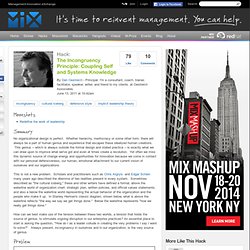
In this section, I'd like to share one way to get at defensive style, and then also discuss how an organization can use the Incongruency Principle to make headway toward innovation. Part I: Your Own Defensive Style I'm going to back into the topic of Defensive Style by starting from something called, "Implicit Leadership Theory," which if you click the link will yield a sample of social sciences research conducted over the last thirty years or so.
ILT simply refers to the fact that we all hold a personal and internal view of what effective leadership is and we use it to both judge others and ourselves. Here's one way to find out about your own ILT: Take a sheet of paper and divide it in half. Now, once you have both lists, go back to the "Vision" side. Example: No one said this was easy work. 1. 2. Personality types. Business Culture: Part 1, Why Is Culture Important. This is the first in a Six-Part series of posts about business culture: · Part 1, Why Is Culture Important · Part 2, Examples of Cultural Challenges · Part 3, Evolution of Culture · Part 4, The Corporate Cultural Network · Part 5, Cultural Inertia.
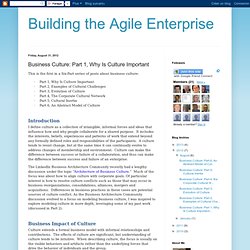
Science of Relationships - Welcome to ScienceOfRelationships.com. Human-Factor Phenomena in Problem Solving. .
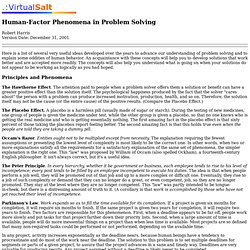
:VirtualSalt Robert Harris Version Date: December 31, 2001. Can Two Rights Make a Wrong?: Insights from IBM's Tangible Culture Approach. “This is the book for people who never get past page two of a management book—it is as close as the genre comes to being a compulsive page turner.

Its main thesis is built on at least three big ideas that are individually persuasive and cumulatively compelling. They naturally fit into an alignment tool that is applied to the range of day-to-day and exceptional challenges all enterprises face, including the Holy Grail of transformational change.” Understanding Workplace Culture for Effective Job Matching. Three Levels of Culture - Schein, Edgard. Cultures surrounds us all.
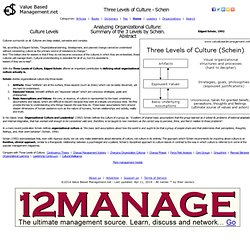
Cultures are deep seated, pervasive and complex. Yet, according to Edgard Schein, "Organizational learning, development, and planned change cannot be understood without considering culture as the primary source of resistance to change. " And "The bottom line for leaders is that if they do not become conscious of the cultures in which they are embedded, those cultures will manage them. Your Big Five Results. Culture mapping. Since I founded XPLANE in 1993, I have worked on many change and innovation initiatives, and one of the most difficult — yet most important — aspects of any business transformation is culture change.
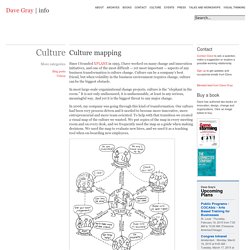
Culture can be a company’s best friend, but when volatility in the business environment requires change, culture can be the biggest obstacle. In most large-scale organizational change projects, culture is the “elephant in the room.” It is not only undiscussed, it is undiscussable, at least in any serious, meaningful way. And yet it is the biggest threat to any major change. In 2006, my company was going through this kind of transformation. The culture mapping tool was so useful that I have long thought it would make an excellent tool for any company that’s dealing with a difficult transformation that will require rethinking, re-imagining or simply shifting the company culture. The Eight Metaphors of Organization. Gareth Morgan’s Images of Organization is a must-read for those who want to develop a deeper understanding of a lot of the stuff I talk about here.
Though I’ve cited the book lots of times, it is one of those dense, complex books that I am never going to attempt to review or summarize. You’ll just have to read it. But I figured since I refer to it so much, I need at least a simple anchor post about it. So I thought I’d summarize the main idea with a picture, and point out some quick connections to things I have written/plan to write. (For once, the picture was complex enough that I chose to draw it and scan it in, instead of doing one of my ugly MS-Paint sketches). Morgan’s book is based on the premise that almost all our thinking about organizations is based on one or more of eight basic metaphors.
Organizational behavior. Organizational behavior (OB) is "the study of human behavior in organizational settings, the interface between human behavior and the organization, and the organization itself.
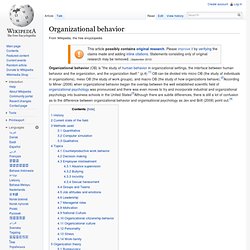
" (p.4) [1] OB can be divided into micro OB (the study of individuals in organizations), meso OB (the study of work groups), and macro OB (the study of how organizations behave).[2]According to Miner (2006) when organizational behavior began the overlap between the well established scientific field of organizational psychology was pronounced and there was even moves to try and incorporate industrial and organizational psychology into business schools in the United States[3]Although there are subtle differences, there is still a lot of confusion as to the difference between organizational behavior and organisational psychology as Jex and Britt (2008) point out.[4] History[edit]